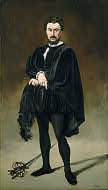
|
Edouard Manet (artist) French, 1832 - 1883 The Tragic Actor (Rouvière as Hamlet), 1866 oil on canvas Overall: 187.2 x 108.1 cm (73 11/16 x 42 9/16 in.) framed: 216.6 x 138.4 cm (85 1/4 x 54 1/2 in.) Gift of Edith Stuyvesant Gerry 1959.3.1 |
Object 5 of 7
Philibert Rouvière stands before us as he did before Parisian theatergoers as Shakespeare’s melancholy prince of Denmark, isolated on stage during one of the play’s great soliloquies. The actor, who had been trained as a painter, modeled his portrayal of Hamlet on engravings by Delacroix of scenes from the play. Critics were pleased with Rouvière’s highly pitched, emotional performance, but not the public. He ended his career destitute and discouraged and died shortly before Manet completed this portrait.
There was a long French tradition of painting actors in their most famous roles, but Manet’s Rouvière may also owe something to a work by Velázquez that Manet saw in Spain, where he had gone in 1865 following the controversy stirred by Olympia. Here, as in Velázquez’ painting, only the angular shadows cast by the actor’s legs anchor him to the ground; we concentrate only on the particulars of his posture, expression, and the minimal props around him. His costume is an orchestration of blacks—glossy or flat, tinged with blues or greens or browns—applied with the kind of energetic brushstrokes that Manet admired in the work of Velázquez, whom Manet once praised as the “painter of painters.”
| « | back to gallery | » | continue tour |


